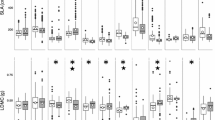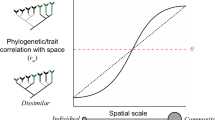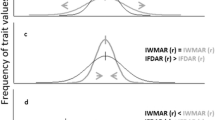Abstract
Environmental filtering and niche differentiation are processes proposed to drive community assembly, generating nonrandom patterns in community trait distributions. Despite the substantial intraspecific trait variation present in plant communities, most previous studies of trait-based community assembly have used species mean trait values and therefore not accounted for intraspecific variation. Using a null model approach, I tested for environmental filtering and niche differentiation acting on three key functional traits—vegetative height, specific leaf area (SLA), and leaf dry matter content (LDMC)—in old-field plant communities. I also examined how accounting for intraspecific variation at the among-plot and individual levels affected the detection of nonrandom assembly patterns. Tests using fixed species mean trait values provided evidence of environmental filtering acting on height and SLA and niche differentiation acting on SLA. Including plot-level intraspecific variation increased the strength of these patterns, indicating an important role of intraspecific variation in community assembly. Tests using individual trait data indicated strong environmental filtering acting on all traits, but provided no evidence of niche differentiation, although these signals may have been obscured by the effects of dispersal limitation and spatial aggregation of conspecific individuals. There was also strong evidence of nonrandom assembly of individuals within single species, with the strength of environmental filtering varying among species. This study demonstrates that, while analyses using fixed species mean trait values can provide insights into community assembly processes, accounting for intraspecific variation provides a more complete view of communities and the processes driving their assembly.


Similar content being viewed by others
References
Albert CH et al (2010) Intraspecific functional variability: extent, structure and sources of variation. J Ecol 98:604–613
Anten NPR, Hirose T (2003) Shoot structure, leaf physiology, and daily carbon gain of plant species in a tallgrass meadow. Ecology 84:955–968
Ashton IW, Miller AE, Bowman WD, Suding KN (2010) Niche complementarity due to plasticity in resource use: plant partitioning of chemical N forms. Ecology 91:3252–3260
Belcher J, Keddy P, Twolan-Strutt L (1995) Root and shoot competition intensity along a soil depth gradient. J Ecol 83:673–682
Bolnick DI et al (2011) Why intraspecific trait variation matters in community ecology. Trends Ecol Evol 26:183–192
Booth RE, Grime JP (2003) Effects of genetic impoverishment on plant community diversity. J Ecol 91:721–730
Cornelissen JHC et al (2003) A handbook of protocols for standardised and easy measurement of plant functional traits worldwide. Aust J Bot 51:335–380
Cornwell WK, Ackerly DD (2009) Community assembly and shifts in plant trait distributions across an environmental gradient in coastal California. Ecol Monogr 79:109–126
Cornwell WK, Schwilk LDW, Ackerly DD (2006) A trait-based test for habitat filtering: convex hull volume. Ecology 87:1465–1471
Falster D (2003) Plant height and evolutionary games. Trends Ecol Evol 18:337–343
Fonseca C, Overton J, Collins B, Westoby M (2000) Shifts in trait-combinations along rainfall and phosphorus gradients. J Ecol 88:964–977
Freschet GT, Cornelissen JHC, van Logtestijn RSP, Aerts R (2010) Evidence of the “plant economics spectrum” in a subarctic flora. J Ecol 98:362–373
Fridley JD, Grime JP (2010) Community and ecosystem effects of intraspecific genetic diversity in grassland microcosms of varying species diversity. Ecology 91:2272–2283
Fridley JD, Grime JP, Bilton M (2007) Genetic identity of interspecific neighbours mediates plant responses to competition and environmental variation in a species-rich grassland. J Ecol 95:908–915
Garnier E, Shipley B, Roumet C, Laurent G (2001) A standardized protocol for the determination of specific leaf area and leaf dry matter content. Funct Ecol 15:688–695
Garnier E et al (2004) Plant functional markers capture ecosystem properties during secondary succession. Ecology 85:2630–2637
Gaudet CL, Keddy PA (1988) A comparative approach to predicting competitive ability from plant traits. Nature 334:242–243
Gotelli NJ, Graves G (1996) Neutral models in ecology. Smithsonian Institution, Washington
Gotelli NJ, McCabe DJ (2002) Species co-occurrence: a meta-analysis of J. M. Diamond’s assembly rules model. Ecology 83:2091–2096
Grime JP (2006) Trait convergence and trait divergence in herbaceous plant communities: mechanisms and consequences. J Veg Sci 17:255–260
Gubsch M et al (2011) Differential effects of plant diversity on functional trait variation of grass species. Ann Bot 107:157–169
Harper JL (1977) Population biology of plants. Academic, London
Hartnett D, Bazzaz F (1985) The genet and ramet population dynamics of Solidago canadensis in an abandoned field. J Ecol 73:407–413
Hubbell SF (2001) The unified neutral theory of biodiversity and biogeography. Princeton University Press, Princeton
Hughes AR, Stachowicz JJ (2004) Genetic diversity enhances the resistance of a seagrass ecosystem to disturbance. Proc Natl Acad Sci USA 101:8998–9002
Hulshof CM, Swenson NG (2010) Variation in leaf functional trait values within and across individuals and species: an example from a Costa Rican dry forest. Funct Ecol 24:217–223
Jung V et al (2010) Intraspecific variability and trait-based community assembly. J Ecol 98:1134–1140
Kraft NJB, Ackerly DD (2010) Functional trait and phylogenetic tests of community assembly across spatial scales in an Amazonian forest. Ecol Monogr 80:401–422
Kraft NJB, Valencia R, Ackerly DD (2008) Functional traits and niche-based tree community assembly in an Amazonian forest. Science 322:580–582
Lepš J, de Bello F, Šmilauer P, Doležal J (2011) Community trait response to environment: disentangling species turnover vs intraspecific trait variability effects. Oikos 34:856–863
Mason NWH, de Bello F, Doležal J, Lepš J (2011) Niche overlap reveals the effects of competition, disturbance and contrasting assembly processes in experimental grassland communities. J Ecol 99:788–796
Messier J, McGill BJ, Lechowicz MJ (2010) How do traits vary across ecological scales? A case for trait-based ecology. Ecol Lett 13:838–848
Nathan R, Muller-Landau H (2000) Spatial patterns of seed dispersal, their determinants and consequences for recruitment. Trends Ecol Evol 15:278–285
Paine CET, Baraloto C, Chave J, Hérault B (2011) Functional traits of individual trees reveal ecological constraints on community assembly in tropical rain forests. Oikos 120:720–727
Peet RK, Wentworth TR, White PS (1998) A flexible, multipurpose method for recording vegetation composition and structure. Castanea 63:262–274
Reich PB et al (2003) The evolution of plant functional variation: traits, spectra, and strategies. Int J Plant Sci 164:S143–S164
Roscher C et al (2011) Legume species differ in the responses of their functional traits to plant diversity. Oecologia 165:437–452
Schamp BS, Chau J, Aarssen LW (2008) Dispersion of traits related to competitive ability in an old-field plant community. J Ecol 96:204–212
Shipley B, Vile D, Garnier E (2006) From plant traits to plant communities: a statistical mechanistic approach to biodiversity. Science 314:812–814
Siefert A (2012) Spatial patterns of functional divergence in old-field plant communities. Oikos (in press)
Stubbs WJ, Wilson JB (2004) Evidence for limiting similarity in a sand dune community. J Ecol 92:557–567
Thuiller W et al (2010) Variation in habitat suitability does not always relate to variation in species’ plant functional traits. Biol Lett 6:120–123
Uriarte M et al (2010) Trait similarity, shared ancestry and the structure of neighbourhood interactions in a subtropical wet forest: implications for community assembly. Ecol Lett 13:1503–1514
Verhoeven KJF, Simonsen KL, McIntyre LM (2005) Implementing false discovery rate control: increasing your power. Oikos 108:643–647
Violle C et al (2012) The return of the variance: intraspecific variability in community ecology. Trends Ecol Evol 27:244–252
Weiher E, Keddy PA (1995) Assembly rules, null models, and trait dispersion: new questions from old patterns. Oikos 74:159–164
Weiher E, Clarke GDP, Keddy PA (1998) Community assembly rules, morphological dispersion, and the coexistence of plant species. Oikos 81:309–322
Westoby M et al (2002) Plant ecological strategies: some leading dimensions of variation between species. Annu Rev Ecol Syst 33:125–159
Wright IJ et al (2004) The worldwide leaf economics spectrum. Nature 428:821–827
Acknowledgments
I thank Mark Ritchie for advice that improved this research; Jason Fridley, Nathan Kraft, Vincent Jung, C.E. Timothy Paine, and an anonymous reviewer for insightful comments on an earlier version of this manuscript; Maureen Carey for help with trait measurements; and Tom Hughes for providing access to field sites. This material is based upon work supported by the National Science Foundation Graduate Research Fellowship. The data were collected in compliance with current United States laws and with required permission.
Conflict of interest
The author declares that he has no conflict of interest.
Author information
Authors and Affiliations
Corresponding author
Additional information
Communicated by Bryan Foster.
Rights and permissions
About this article
Cite this article
Siefert, A. Incorporating intraspecific variation in tests of trait-based community assembly. Oecologia 170, 767–775 (2012). https://doi.org/10.1007/s00442-012-2351-7
Received:
Accepted:
Published:
Issue Date:
DOI: https://doi.org/10.1007/s00442-012-2351-7




